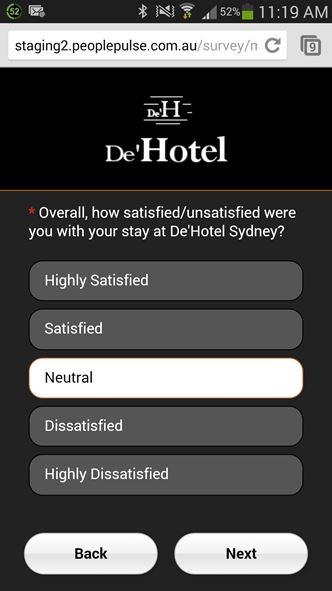
What is the right number of questions per page?
The number and layout of questions on a screen is one of the most important formatting considerations in influencing response rates for mobile surveys. The ease of use of mobile questionnaires and how each question is laid out on the screen is crucial, as this can have a massive impact on whether respondents complete the survey or not.
In addition to decisions such as question length and which question types you’ll use, an obvious point to consider is how many questions to show on each page. Do you break your survey up completely so each question has a page dedicated to it? Or do you attempt to minimise the total number of pages by fitting in as many questions as possible on the screen?
To answer this query, one needs to remember one of the biggest issues with mobile surveys – that they differ vastly in terms of form, functionality and aesthetics to questionnaires delivered and answered on desktop. In this edition of Mobile Matters, we examine the implications of these differences, and take a look at just how many questions you should have per page in your mobile survey.
Will the respondent make it past the first screen?
If your survey is crammed with too many questions per screen, chances are the respondent will drop out even before getting through the first one.
A study by Decipher looked into how many respondents dropped out of online surveys on the first page – and found marked differences between mobile surveys and those on other platforms. Well over half (56 per cent) of those answering on smartphone dropped out on the first page, compared to 46 per cent on tablets and 48 per cent on desktops.
A key implication here is that ensuring your question is displayed well on whatever screen size your respondent is likely to be using is crucial to sustained engagement with the respondent. We’ve all seen the mobile surveys with the tiny answer buttons that only a child’s finger would be capable of selecting, the scroll bars on either side of the screen that by the time you scroll to the answer option you think you want you’ve forgotten what the question was and question text so tiny you need a magnifying lens to read it. Thankfully these days the better survey tools can distinguish between a mobile and a desktop to ensure that the question is displayed in an appropriate way.
If you demonstrate from the very start that there is an easy number of questions to deal with per page, you can increase the chances of the respondent continuing with and completing the survey.
So how many questions should you have on each page?
Going solo: Why one question works
With mobile surveys, best practice is to keep it simple, break up the questionnaire and have just one question per page. There are two very important reasons for this:
1. It reduces respondent fatigue
Having a number of questions on each page is usually acceptable and in any case scrolling down is easy on a desktop survey, since respondents can usually see all of the questions on one screen. However, for a mobile survey, having too many questions means respondents have to continually scroll down on every page – often leading to fatigue, frustration and early abandonment.
This can also present a problem for those who may have slightly larger fingers. The need to scroll down aside, there’s the chance they accidentally select the wrong answer option as they navigate down the page.

The best way to solve this problem? Don’t make your respondents scroll at all. Allocate just one question per page, and let respondents answer it and swipe to the next one.
2. It improves survey load times
Trying to cram in five or more questions on one screen will not only make your survey look too hectic, it can also slow down its progress and further hurt response rates.
The more questions you have on a page, the longer it takes to load. If respondents are having to repeatedly wait for each dense, question-heavy page to fully load you’re giving them a valid reason to drop out.
Limiting the number of questions to just one a page is therefore the way to go. This way, respondents have a clear point of focus on each page and can quickly swipe through to its completion.
Happy surveying!
Ready to run to your next research project?
We’d love to speak with you to see if we can assist with your next mobile research project – please give us a call on +61 2 9232 0172 and ask for an obligation-free quote from one of our Business Solutions team members. Alternatively, drop us a note.
![]() Get a Demo:
Get a Demo:
We have helped over 1,000 organisations to utilise feedback as a means to improve employee engagement and increase customer satisfaction and referrals. And now we’d love to help you!
Phone us on +61 2 9232 0172 or submit your demo request today via the form below:

 Exceptional Survey. Solutions
Exceptional Survey. Solutions